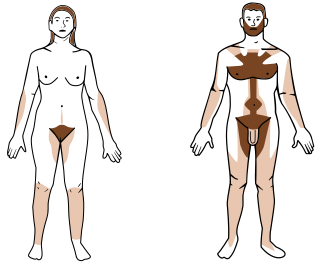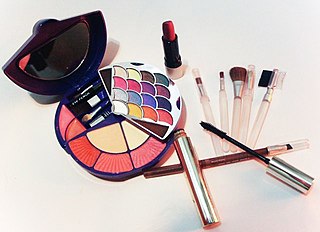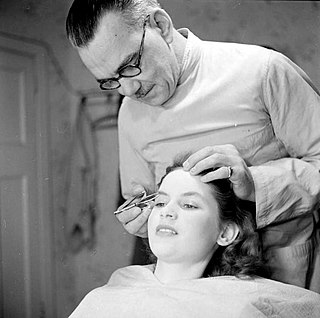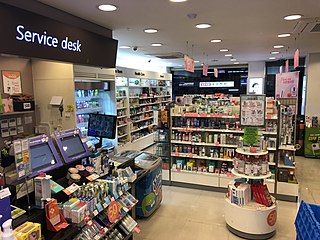Background and history
| | This section is empty. You can help by adding to it. (February 2021) |
Male grooming refers to men paying attention to fashion and enhancing their own appearance. This interest has become increasingly apparent in popular culture. [1]
| | This section is empty. You can help by adding to it. (February 2021) |
According to Statista, by 2024 the global male grooming market is estimated to be worth about US $81.2 billion. [2]
South Korea has become a center of cosmetics use by men due to "appearance competition", where men wear makeup to compete in tight job markets. The Korean wave cultural phenomenon, which includes K-pop, has also strongly influenced male grooming. As pop idols in their 20s and so-called "flower boys" [3] have grown in popularity, the perception of men's makeup has changed. While it was once common for men who wore makeup to be associated with drag queens or homosexuality in western cultures, Korean male idols, although they are boyish in appearance, otherwise project masculinity. Men are encouraged to copy the makeup of Korean male idols. In fashion and beauty magazines overseas, there are many articles on skin care and makeup tutorials inspired by Korean pop stars. [4]
The "woman-like man" has become a new trend in China, where a growing number of young men are interested in makeup. [5] The number of internet broadcasters and beauty bloggers who produce makeup videos for men has increased rapidly. Accordingly, the men's cosmetics industry has grown rapidly in China. According to German market-research firm Statista, the size of the men's cosmetics industry in China reached 201.3 billion yuan as of May 2018. Chinese e-commerce company JD.com said that the sales of beauty products for men has more than doubled since 2015. Mask packs, BB cream, and lipstick are popular products. [6]
Men's grooming has grown substantially in the US and is projected to grow over the next[ when? ] decade. [7]
Barber shops are also one of the places that can assist modern grooming men. Barbers are licensed professionals who are trained to cut, shave, and style head hair and beards. Male grooming products—including pomades, shave products, powder, beard oil, and shampoo and conditioners—can be purchased at barbershop.
Interest in eyebrow trimming and eyebrow makeup has also increased, [8] and sales of eyebrow beauty tools have increased in the last few years. [9] [10]
The grooming of male bodily hair has a long history in human culture for both cultural, aesthetic, sexual and practical purposes (see: History of male body grooming).
From the ancient Egyptians and Greeks up until modern times, the trimming or removing of body hair has been particularly popular among athletes, for whom it can provide a slight competitive edge in activities such as wrestling, running, swimming, and more recently, cycling (see: Reasons for grooming).
In recent decades, male bodily hair removal and trimming, as distinct from head hair grooming activities, has seen a revival for aesthetic and sexual purposes. This rising prevalence has led to the coining of the term 'manscaping' as a specific neologism to describe the practice. [11] The term is a portmanteau of the words 'man' and 'landscaping', and its first known use was in 2003. [12]

Men's cosmetics products—toners, fragrances, and lotions—have gained a foothold in the mainstream market. In addition, cosmetics that can be used by either men or women have become popular. [13]
The Korean men's cosmetics market has steadily grown from 733 billion won, in 2010, to 1.23 trillion won, in 2016, and to 1.23 trillion won (c. US $1.1 bn), in 2018. About 75% of Korean men use cosmetics more than once a week, according to global data from overseas market research institutions, which indicates that the percentage of men who use cosmetics in Korea is higher than that of other countries. [14]
According to a recent survey by Mintel, a global market research firm, 70% of 1,000 American men use sunscreen, and 67% of men use cosmetics for their facial skin. [15]
BB cream is used to heighten skin tone. [16] Men's BB cream is characterized by its delicate and natural persistence. This covers skin defects, but does not look like one is wearing makeup. [17]
Eyebrow pencil is used to sculpt the eyes by accentuating the contour of the brows and define the brows for a natural look. Men with sparse or thin brows use eyebrow pencil for fuller-looking brows. [18]
Lip balm is a beauty item that is easily available to men who don't wear makeup. Colored lip balm is popular because it is used not only for moisturizing but also to help with skin tone. Colored lip balm is suitable for men who prefer a natural look because it can brighten lips with color that compliments natural skin tone, but more subtly than lipstick or tint. [19] [14]
Men are willing to go to the operating room to make a favorable impression. [20]
Men with small wrinkles on their faces, such as around the eyes and mouth, are seeking Botox treatments, such as what women get. [21] Middle-aged men get Botox surgery for skin regeneration and wrinkle removal in the hope of securing a new job. [22]
The eyebrows play a big role in facial expression to the extent that they are called "the roof of the face".[ citation needed ] Over 100,000 years, the role of eyebrows has become more important as the size of human faces has become smaller and the facial lines have become smoother.[ citation needed ] Dark eyebrows on a small face make other people more aware of facial expressions. [23] Recently, there has been a trend of men tattooing their eyebrows. The process of a permanent eyebrow tattoo involves designing the eyebrows and filling with pigment. [24]
Male contouring injection surgery removes fat from the face and creates clearly defined facial features. [25]
Men are having laser treatments for permanent removal of facial and body hair. [26]
When asked "What do you think are the criteria for a nice man?", in a survey conducted by the Korea National Statistical Office, "look and fashion" accounted for 22.7%, followed by character, economy, and values. When asked "What do you think of a well-dressed man?", 37.2% thought "cool" and 30.1% said "I want to try". [27] In addition, there is the phenomenon of men valuing appearance over ability. People are undergoing cosmetic surgery to make favorable impressions during interviews. [28] As a result of the perception that a change in facial shape improves first impressions, facial contouring surgery is becoming popular across industries. [29]
There has been a growth in corporate gifting to align with the demand for men's grooming products. [30] Men with sharp features are finding opportunities in conventional advertising. Both men and women have changed their perception of men looking after their appearance in relation to being competitive in the job market and in marrying. [29]

Hair removal, also known as epilation or depilation, is the deliberate removal of body hair or head hair.

Cosmetics are composed of mixtures of chemical compounds derived from either natural sources or synthetically created ones. Cosmetics have various purposes, including personal and skin care. They can also be used to conceal blemishes and enhance natural features. Makeup can also add colour to a person's face, or change the appearance of the face entirely to resemble a different person, creature, or object.

An eyebrow is an area of short hairs above each eye that follows the shape of the lower margin of the brow ridges of some mammals. In humans, eyebrows serve two main functions: first, communication through facial expression, and second, prevention of sweat, water, and other debris from falling down into the eye socket. It is common for people to modify their eyebrows by means of hair removal and makeup.

Threading is a method of hair removal for both men and women originating in India and Central Asia. It has gained popularity in Western countries, especially with a cosmetic application.

Permanent makeup, also known as permanent cosmetics, derma-pigmentation, micro-pigmentation, semi-permanent makeup and cosmetic tattooing, is a cosmetic technique which employs tattoos as a means of producing designs that resemble makeup, such as eye-lining and other permanent enhancing colors to the skin of the face, lips, and eyelids. It is also used to produce artificial eyebrows, particularly in people who have lost them as a consequence of old age, disease, such as alopecia areata, alopecia totalis, chemotherapy, or a genetic disturbance, and to disguise scars and hypopigmentation in the skin such as in vitiligo. It is also used to restore or enhance the breast's areola, such as after breast surgery, or to give an illusion of more hair volume to the scalp.

The history of cosmetics spans at least 7,000 years and is present in almost every society on earth. Cosmetic body art is argued to have been the earliest form of a ritual in human culture. The evidence for this comes in the form of utilised red mineral pigments including crayons associated with the emergence of Homo sapiens in Africa. Cosmetics are mentioned in the Old Testament—2 Kings 9:30 where Jezebel painted her eyelids—approximately 840 BC—and the book of Esther describes various beauty treatments as well.

Plucking or tweezing can mean the process of human hair removal, removing animal hair or a bird's feathers by mechanically pulling the item from the owner's body. In humans, hair removal is done for personal grooming purposes, usually with tweezers. An epilator is a motorised hair plucker. Those under the influence of deliriants or trichotillomania may pluck their own hair out of habit.
Aesthetic medicine is a branch of modern medicine that focuses on altering natural or acquired unwanted appearance through the treatment of conditions including scars, skin laxity, wrinkles, moles, liver spots, excess fat, cellulite, unwanted hair, skin discoloration, spider veins and or any unwanted externally visible appearance. Traditionally, it includes dermatology, oral and maxillofacial surgery, reconstructive surgery and plastic surgery, surgical procedures, non-surgical procedures, and a combination of both. Aesthetic medicine procedures are usually elective. There is a long history of aesthetic medicine procedures, dating back to many notable cases in the 19th century, though techniques have developed much since then.

BB cream is a marketing term that stands for blemish balm, blemish base, beblesh balm, and in Western markets, beauty balm, beauty blend... Products marketed as BB creams are generally designed to serve as a foundation, moisturizer, and sunscreen all at once.
The feminine beauty ideal is a specific set of beauty standards regarding traits that are ingrained in women throughout their lives and from a young age to increase their perceived physical attractiveness. It is experienced by many women in the world, though the traits change over time and vary in country and culture.

A makeup brush is a tool with bristles, used for the application of makeup or face painting. The bristles may be made out of natural or synthetic materials, while the handle is usually made out of plastic or wood. When cosmetics are applied using the appropriate brush, they blend better onto the skin.

The cosmetic industry describes the industry that manufactures and distributes cosmetic products. These include colour cosmetics, like foundation and mascara, skincare such as moisturisers and cleansers, haircare such as shampoos, conditioners and hair colours, and toiletries such as bubble bath and soap. The manufacturing industry is dominated by a small number of multinational corporations that originated in the early 20th century, but the distribution and sale of cosmetics is spread among a wide range of different businesses. Cosmetics must be safe when customers use them in accordance with the label's instructions or in the conventional or expected manner. One measure a producer may take to guarantee the safety of a cosmetic product is product testing. FDA occasionally does testing as part of its research program or when looking into potential safety issues with a product. Both the cosmetics business and consumers can benefit from the FDA's resources on product testing.

Cosmetics have been used in Korea since antiquity. Today, cosmetics are an important industry in South Korea.

Korean beauty standards have become a well-known feature of Korean culture. In 2015, a global survey by the International Society of Aesthetic Plastic Surgeons placed South Korea in the top ten of countries who had the highest rate of cosmetic surgeries.

K-beauty is an umbrella term for skincare products that are derived from South Korea. The fad gained popularity worldwide, especially in East Asia, Southeast Asia, South Asia, and the Western world, and focuses on health, hydration, and an emphasis on brightening effects.

CJ Olive Young Corporation is a health and beauty product store based in South Korea. Olive Young opened its first store in Sinsa-dong, Gangnam in December 1999 under the management of CJ Systems and pioneered Korea's health and beauty market. Olive Young's main slogan is "All live young with Olive Young." which reflects the main philosophy 'Natural Healthy' of Olive Young. In 2021, Olive Young is solidifying its No.1 position in the Korean H&B market, which was hit directly by Covid-19.

Victorian-era cosmetics were cosmetic products used during the Victorian age. Victorian cosmetics sometimes used toxic ingredients such as lead, mercury, arsenic, and ammonia.
Japanese female beauty practices and ideals are a cultural set of standards in relevance to human physical appearance and aesthetics. Distinctive features of Japanese aesthetics have the following qualities: simplicity, elegance, suggestion, and symbolism. Concepts of female beauty originate from its traditional culture which has lasted for more than a century, some of which include skin whitening, long straight hair, and slim eyes. According to Kowner and Ogawa, the modern concept of physical attractiveness in Japan emanates from distinct, native traditions that have persisted for more than a century despite pervasive Western influence of values and ideals.
Male cosmetics include all cosmetic products marketed towards men, such as makeup, skincare products, hair care products, body care products, sun care products, perfumes, and other decorative cosmetics.

Cosmetic surgery is voluntary or elective surgery for beauty enhancement. The motivation for plastic surgery has been debated throughout Korean society. Holliday and Elfving-Hwang suggest that the pressure of success in work and marriage is deeply rooted in one's ability to manage their body which is influenced by beauty. As companies helping with matchmaking for marriage and even job applications require a photo of the individual, Korean population inevitably feels pressure to undergo plastic surgery to achieve the "natural beauty".